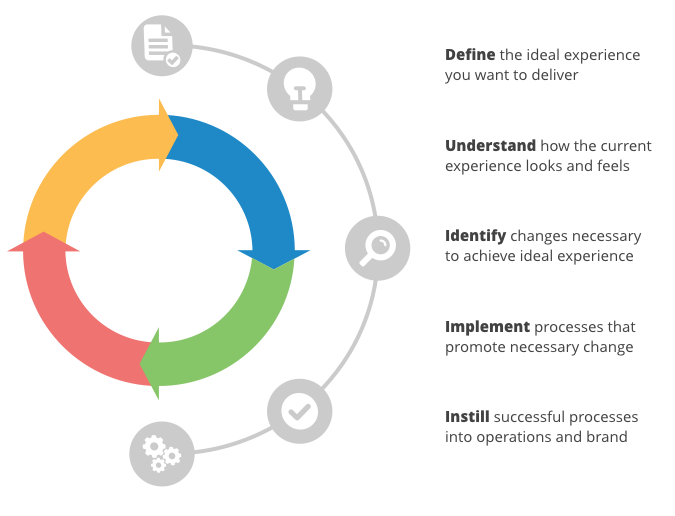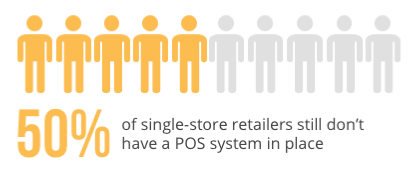Retail Store Operations Are Either Growing or Dying—Which Are You?
The “great retail apocalypse of 2017” was greatly blown out of proportion.
Sure, some stores closed (and have been closing since 2015), but the cause of these closures wasn’t some ominous ambiguity, as it was so typecast.
The swath of store closures in 2017 was the result of stagnation on the part of their brands, their customer experiences and their process and technology innovation.
As a small business retailer, these “apocalyptic” downfalls signal a fork in your road:
Down one path, you keep chugging along with an “if it’s not broken, don’t fix it” attitude. There’s little risk here—asigde from the long-term viability of your business.
Down the other path, you strive for continuous improvement, invest in new retail tools and focus on disruptive consumer and operational technologies. This path is harder, with greater risk—but the risk is spread across many facets of the business.
Read on to learn more about blazing a trail down the second path.
Here’s what we’ll cover:
Define Your Optimal Experience and Train Employees to Consistently Deliver It
Harness Retail Tools for Process Improvements—Your Competitors Already Are
Build a Strong Foundation to Ride the Wave of Coming Retail Tech Disruption
Define Your Optimal Experience and Train Employees to Consistently Deliver It
A consistently positive customer experience is the most important component of your retail store operation. It’s the key differentiator between you and your competitors.
According to Salesforce research, 75 percent of consumers expect a consistent experience whenever they engage with your brand. And if you fail in today’s retail market, the same research found 70 percent of consumers say new technology makes it easier than ever to take their business elsewhere.
With such tremendous stakes, you must design and deliver a consistent positive customer experience. These develop loyal customer bases and encourage customers to advocate for your business.
Here’s a roadmap to help you create and/or improve your operations’ customer experience.
Customer Experience Optimization Roadmap

Five steps for optimizing your customer experience. Keep in mind that experience improvement is perpetual. You should constantly be looking for improvements.
The majority of your customer experience refinement will take place behind the scenes—new technologies, brand and marketing best practice, and operational process improvement.
There’s an unavoidable, often overlooked facet that’s crucial to your customer experience: in-store interactions between customers and associates.
Training your store associates on personal communication skills is crucial. But what about an ongoing resource to help associates ensure they’re providing the best possible experiences to in-store customers?
Something like this simple customer experience checklist below can help even the best store associates ensure they’re optimizing experiences with each interaction.
Daily Retail Customer Experience Checklist
| Gauge customer’s initial mood and intent to determine the type of greeting, if any, to welcome them to the store. |
| If engaging with customer, first welcome them to the store, then introduce yourself and ask why they’ve stopped in. |
| Listen! Listen! LISTEN! Be attentive of what is said as well as what the customer means. |
| Assist customer to the best of your ability or immediately pass them to someone else if you can’t be of service. |
| Know the store: location of products, product details, inventory counts, current deals, online store tools, shipping availability and rates, etc. |
| Provide customer with the easiest possible checkout/payment process. |
| When possible, leave the customer with incentive to come back into the store. |
Ideally, these principles will eventually become second nature and associates won’t need to reference the checklist frequently. But it’s great to have on hand as a way to gauge the success of an interaction aside from “sale” vs. “no sale.”
Co-workers can hold each other accountable for subpar experiences, and managers can reference the list for opportunities to learn and improve.
Harness Retail Tools for Process Improvements—Your Competitors Already Are
What are the processes that drive your retail operation? Probably some combination of the following:
![]()
These are typical processes shared by all retail businesses. But top performing retail businesses are those that have optimized these core process and continually innovate new ways to achieve business success.
Here’s three core process improvements you can adopt to launch your business above your competitors:
 Manage Your Inventory Management
Manage Your Inventory Management
A shocking 50 percent of single-store retailers don’t have a point of sale (POS) system in place. These businesses are using manual methods to monitor their POS system, which is a tedious, unnecessary process given the availability of inventory management tools prominent both on their own and packaged within POS systems.
It’s crucial that you adopt an inventory management system.
It removes loads of human error from such an important process. It frees up you and your staff to spend more time with customers, building the business. So whether your system is outdated, underperforming, or non-existent, here are three quick steps to take to move your inventory onto a new inventory management system:
1. Get an exact count of your current inventory—including various product details. Rather than saying 10 lamps, it should be as detailed as 10 floor lamps, golden, with stomp switch—and so on for the rest.
2. Once you’ve got a detailed breakdown of your existing inventory, assign them a stocking keeping unit (SKU) number. This enables you to easily store and recall an exact product to see inventory counts.
3. Finally, you’ll want to take full advantage of the capabilities afforded to you with inventory management systems. This includes setting up alerts and notifications when certain inventory falls below a set threshold. You can even go as far and set parameters for automatically reordering products from vendors.
Check out our How To Inventory Items With Your POS Software report to get a more detailed breakdown of this process.
 Key Up Your KPIs
Key Up Your KPIs
Data is the new oil, and your store is an oil well. To put it bluntly: If you want to sustain your business, you must start gathering data and implement retail key performance indicators (KPIs).
Much like inventory management above, most all POS software supports at least basic reporting and analytics capabilities—certainly enough for you to monitor these three must-have retail KPIs:
1. Total sales: Tracks the total number of sales (in terms of dollars, items, etc.) across your business(es).
2. Store traffic: Refers to the total number of visitors that come into your store (in-store or online) regardless of whether they make a purchase or not.
3. Profit margins: Your gross profit margin is the percent difference in the cost of the product and amount it is sold for.
Check out our 3 Retail KPIs To Help Your Business Flourish report to learn more about why and how to get these KPIs up and running.
 Get Your Business Online
Get Your Business Online
Our third retail store operations process improvement is taking your point of sale online. You’ve got to get an online store up and running. It might seem daunting, but here are some steps you can take to open your business up to the world wide web:
1. Ensure that your POS connects to your e-commerce system: Many modern POS vendors also offer e-commerce capabilities. This is highly beneficial as it provides one backend (reporting, inventory, customer management, etc.) which supports both in-store and online sales.
2. Get the key e-commerce capabilities: Set yourself up for future success by bringing on an e-commerce solution with specialized capabilities like marketplace management, mobile-friendly design, and backend integrations for shipping and other crucial processes.
3. Develop online marketing for your online store: Get a differentiated plan in place for marketing your online store. There’s different metrics and platforms that you’ll want to monitor for marketing your online store than marketing your physical store.
Check out our Everything Retail Stores Starting an Online Business Need to Know report to learn more about how to best take your retail operations online.
Build a Strong Foundation to Ride the Wave of Coming Retail Tech Disruption
Gartner’s Top Technology Trends for SMBs research1 found that 24 percent of small retail businesses list “using the right technologies” as one of the top constraints for achieving their business goals. We also know from the many free consultations we have everyday that 50 percent of single-store business don’t have a POS in place.

There’s a very real issue with technology adoption and usage for small business and especially so for small retail businesses. You must overcome this. And you must do so soon because there’s a wave of paradigm-shifting technologies set to disrupt commerce as we know it.
Let’s take a quick look at two of these technologies:
1. Unified Retail Commerce
Unified retail commerce is rooted in providing customer-centric experiences that are based on individual consumer shopping preferences and that aren’t limited by channel capabilities.
There’s not a modern retailer on this planet that hasn’t heard the term “omnichannel” spewed around the industry. Well the promise of omnichannel is actually coming to light with unified commerce technology.
This is a lot to take in, which is why we’ve dedicated an article to it. Take a look and learn how you can move to a unified commerce approach. Just know for now that any successful retailers who haven’t invested heavily in a unified approach will be few and will be the outliers.
2. Buy Online, Pickup In-Store (BOPIS)
A BOPIS retail strategy isn’t just reserved for retail giants. With a proper foundation, your small business can offer customers a BOPIS experience.
As long as you can support an online storefront for your business and you have your physical and online inventory tied together, you too can launch a BOPIS strategy. Of course, there’s tons of small retail businesses (perhaps just like you) that don’t have an online store.
If that’s the case, take a look at our in-depth article on starting an online business. Whether you’re interested in BOPIS or not, you’ve got to get an online storefront up and running to reach more consumers with your brand and inventory.
Here’s What To Do Once You’re Done Reading
You’ve made it this far, which means you realize that you need to invest in technology. Hoisting your retail store operations to new heights is going to require at least a baseline set of foundational systems.
Retailers are fortunate in that the POS systems usually offer all the foundational support they need to boost their operation.
And once these foundational systems are in place, you can look to integrate more specialized software like e-commerce platforms, customer relationship management software, and shipping and supply chain management systems.
And wouldn’t you know it—our expert retail software advisors at Software Advice can help you find the best software based on your unique needs. Feel free to check out the many user reviews your retailer peers have left about tons of POS systems on the market.
1Information on Gartner’s Top Technology Trends for SMBs Survey
Gartner conducted this survey in April and May 2017 among 699 U.S.-based SMBs, with more than 10 employees and annual revenue of less than $100 million. The survey excluded nonprofit organizations. The qualified respondents are decision-makers, or have significant influence on the decisions related to purchasing technologies for their organization.